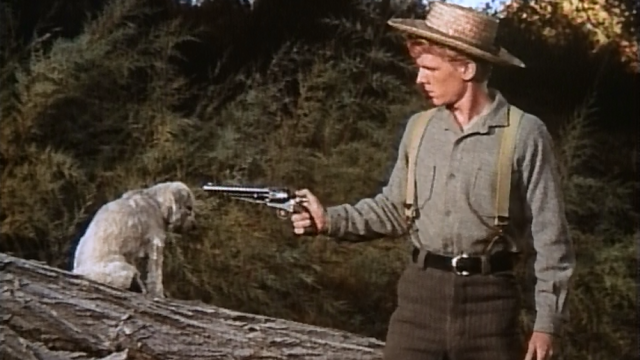The easiest any movie has ever had in casting a character with no hands was The Best Years of Our Lives. You want a guy with hooks for hands, you cast a guy with hooks for hands. And of course the fact that Harold Russell basically never acted again is a whole Thing. (I wonder if Disney thought he was too old for the role here, or if the problem was that he’d lost both hands and not just one; imagine the clever filming around that, if you will.) Still, coming back to this movie for the first time since childhood, the first thing I wondered was how they’d deal with the fact that its main character only had one arm.
John Wesley Powell (John Beal) here seems to only be missing his right hand, is the answer. Still, that’s kind of a big problem for a guy who plans to be the first person to actually explore the Colorado River through the Grand Canyon. He gathers a collection of nine other willing adventurers. They climb into four boats, loaded with provisions for several months, and head off down the Green River at, well, Green River, Wyoming. They are prepared for adventure and danger; the locals assume they will never be heard from again.
The major is interested in science. His brother, Walter (James Drury), is an Andersonville survivor who immediately develops a hatred and distrust of George Bradley (Ben Johnson), whom he decides based on one linguistic quirk is a Confederate. (I don’t think this is ever confirmed.) William “Bill” Dunn (Brian Keith) is a mountain man with a penchant for astrology. Jack Sumner (Dan Sheridan) is an experienced hunter and trapper. Oramel G. Howland (R. G. Armstrong) is a newspaperman; he and his brother, Seneca (Stan Jones) frankly seem a little out of place on the expedition. As does Englishman and drunk Frank Goodman (David Frankham). He shares a boat with cook and recovering alcoholic Billy “Missouri” Hawkins (L. Q. Jones). Finally, there is young Andrew “Andy” Hall (David Stollery) and his dog.
There’s lots of conflict built into these things—Walter is shown as being extremely stressed about his relationship with the major, not to mention furious about the very idea of a Confederate in the group. To show his authority, he decides to make Andy kill the dog, because there was a rule that no dogs were allowed on the expedition, and obviously you can’t just turn a dog loose in the middle of the wilderness. The major changes his mind, and it turns out to be something of a Chekhov’s Dog later in the movie.
Supposedly, not even Native Americans traveled the river; Dawn Little Sky plays “Indian Woman,” who delivers a legend of how the river is the flooded trail to the underworld and no one who’s gone down it survives. I don’t know if she is speaking her own language—she was born on the Standing Rock Reservation—or that of one of the groups who actually live in the area, and obviously I don’t know if what she’s saying is what’s translated for her. It could be the whole thing is invented to give a reason for why the men can’t get guides. I suspect I’d know the truth if I’d ever studied Arizona history.
Probably my least favourite character is Frank Goodman. It’s not just that he’s smuggled a small cask of whiskey along—more dangerous than the dog, let’s be real. The middle of unexplored rapids is no place to be stealing nips of booze. It’s that he’s the kind of drunk who can’t stand to see someone known to be a recovering alcoholic to recover. He keeps pushing. A certain kind of drunk can’t let people just . . . not drink. They may have reasons—and I don’t believe you need reasons to not drink—but the drunk doesn’t care. And if the middle of unexplored rapids is no place to be getting drunk, it’s even less the place to force someone else to get drunk. And so they destroy the boat and a quarter of their supplies and lose some of the major’s equipment.
I’m genuinely surprised, though, to discover that this is usually considered one of Disney’s worst films. I personally think it’s pretty good. It’s well filmed, for one—sure, it’s never entirely convincing when we see rear projections of the men going down the river, and even I can pretend to row better than that. But it’s an intriguing story, one I don’t think most people know. The country, of course, is beautiful. Maybe the character development isn’t all it could be, but most of the ten men feel like distinct characters, and that’s hard to do.
I also don’t know how closely the movie sticks to the historical narrative. Only six of the men made it the whole way; the movie asserts a fate for three of them that we genuinely do not know. They were never seen again. It’s possible the movie is right, and it’s possible they were killed by Mormon settlers who believed they were federal agents. The major went on to be the second director of the US Geological Survey; he and Walter are the only ones shown to be interested in geology for its own sake and not for the sake of figuring out where there’s gold.
Oh, sure, it’s still depressing that it’s probably one of the best movies director William Beaudine ever made. This was one of his last movies; one of the few to come after it was Jesse James Meets Frankenstein’s Daughter. It’s also David Stollery’s last movie, but that’s because he left Hollywood, studied auto design, and went to work for Toyota, where he designed the 1978 Celica, among other things. This is at best mid-range Disney, I grant you, but it’s still worth checking out.
Help finance my watching of weird movies that aren’t on Disney+; consider supporting my Patreon or Ko-fi!

